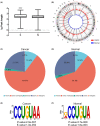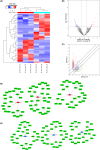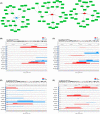Comprehensive analysis of circRNAs for N7-methylguanosine methylation modification in human oral squamous cell carcinoma
- PMID: 37554544
- PMCID: PMC10405248
- DOI: 10.1096/fba.2023-00036
Comprehensive analysis of circRNAs for N7-methylguanosine methylation modification in human oral squamous cell carcinoma
Abstract
N7-methylguanosine (m7G) modification is closely related to the occurrence of tumors. However, the m7G modification of circRNAs in oral squamous cell carcinoma (OSCC) remains to be investigated. Methylated RNA immunoprecipitation sequencing (MeRIP-seq) was used to measure the methylation levels of m7G and identify m7G sites in circRNAs in human OSCC and normal tissues. The host genes of differentially methylated and differentially expressed circRNAs were analyzed by Gene Ontology (GO) enrichment and Kyoto Encyclopedia of Genes and Genomes (KEGG) pathway analyses, and circRNA-miRNA-mRNA networks were predicted using the miRanda and miRDB databases. The analysis identified 2348 m7G peaks in 624 circRNAs in OSCC tissues. In addition, the source of m7G-methylated circRNAs in OSCC was mainly the sense overlap region compared with normal tissues. The most conserved m7G motif in OSCC tissues was CCUGU, whereas the most conserved motif in normal tissues was RCCUG (R = G/A). Importantly, GO enrichment and KEGG pathway analysis showed that the host genes of differentially methylated and differentially expressed circRNAs were involved in many cellular biological functions. Furthermore, the significantly differentially expressed circRNAs were analyzed to predict the circRNA-miRNA-mRNA networks. This study revealed the whole profile of circRNAs of differential m7G methylation in OSCC and suggests that m7G-modified circRNAs may impact the development of OSCC.
Keywords: N7‐methylguanosine (m7G); RNA methylation; circular RNA; methylated RNA immunoprecipitation sequencing (MeRIP‐seq); oral squamous cell carcinoma (OSCC).
© 2023 The Authors. FASEB BioAdvances published by Wiley Periodicals LLC on behalf of The Federation of American Societies for Experimental Biology.
Conflict of interest statement
The authors declare that they have no competing interests.
Figures







Similar articles
-
Transcriptome Mapping of the Internal N7-Methylguanosine Methylome in Messenger RNAs in Human Oral Squamous Cell Carcinoma.Front Biosci (Landmark Ed). 2023 Dec 6;28(12):330. doi: 10.31083/j.fbl2812330. Front Biosci (Landmark Ed). 2023. PMID: 38179755
-
Distinct N7-methylguanosine profiles of circular RNAs in drug-resistant acute myeloid leukemia.Sci Rep. 2023 Sep 7;13(1):14704. doi: 10.1038/s41598-023-41974-w. Sci Rep. 2023. PMID: 37679400 Free PMC article.
-
Landscape of internal N7-methylguanosine of long non-coding RNA modifications in resistant acute myeloid leukemia.BMC Genomics. 2023 Jul 27;24(1):425. doi: 10.1186/s12864-023-09526-8. BMC Genomics. 2023. PMID: 37501118 Free PMC article.
-
Internal m7G methylation: A novel epitranscriptomic contributor in brain development and diseases.Mol Ther Nucleic Acids. 2023 Jan 11;31:295-308. doi: 10.1016/j.omtn.2023.01.003. eCollection 2023 Mar 14. Mol Ther Nucleic Acids. 2023. PMID: 36726408 Free PMC article. Review.
-
RNA-Seq Revealed a Circular RNA-microRNA-mRNA Regulatory Network in Hantaan Virus Infection.Front Cell Infect Microbiol. 2020 Mar 13;10:97. doi: 10.3389/fcimb.2020.00097. eCollection 2020. Front Cell Infect Microbiol. 2020. PMID: 32232013 Free PMC article. Review.
Cited by
-
TRMT10C-mediated m7G modification of circFAM126A inhibits lung cancer growth by regulating cellular glycolysis.Cell Biol Toxicol. 2024 Sep 18;40(1):78. doi: 10.1007/s10565-024-09918-w. Cell Biol Toxicol. 2024. PMID: 39289194 Free PMC article.
References
-
- Ali J, Sabiha B, Jan HU, Haider SA, Khan AA, Ali SS. Genetic etiology of oral cancer. Oral Oncol. 2017;70:23‐28. - PubMed
-
- Shahinas J, Hysi D. Methods and risk of bias in molecular marker prognosis studies in oral squamous cell carcinoma. Oral Dis. 2018;24:115‐119. - PubMed
-
- Sung H, Ferlay J, Siegel RL, et al. Global cancer statistics 2020: GLOBOCAN estimates of incidence and mortality worldwide for 36 cancers in 185 countries. CA Cancer J Clin. 2021;71:209‐249. - PubMed
LinkOut - more resources
Full Text Sources
Molecular Biology Databases
